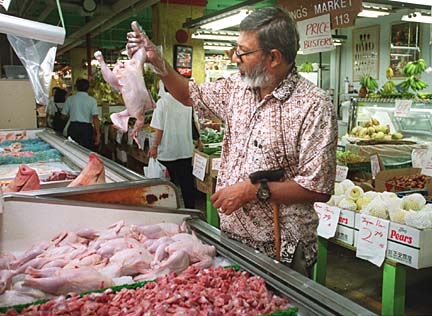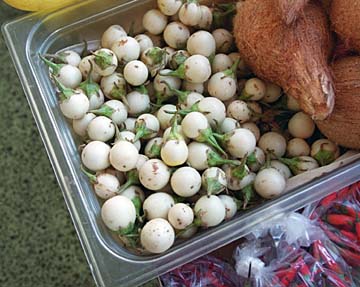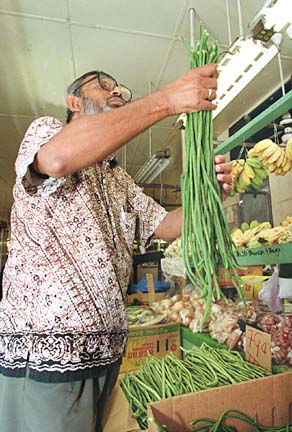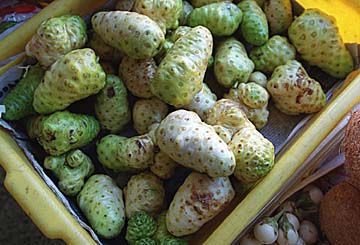


Ong choi, bok choi, choi sum,
gaai choi ... Lyon Arboretum helps
cooks turn over a new leafSTIR-FRIED BITTER MELON WITH BEEF
By Stephanie Kendrick
Star-BulletinHONOLULU'S Chinatown is home to a cosmopolitan array of people, businesses, foods and trinkets, but a few things still stand out.
Among the outstanding sights last Saturday was a tour of 10 haoles led by a Sri Lankan man. Huddled on the crowded sidewalks and in busy store fronts, the group was pretty hard to miss.
Ranjit Cooray, educational specialist for the Lyon Arboretum, has been leading a tour of Chinatown and its ingredients for more than six years.
Cooray says it's fairly common to have an all-haole tour of both newcomers to Hawaii and kama'aina, but there also are many locals who are unfamiliar with Chinatown.
"I know there are lots of local people who really don't know anything about what can be found in Chinatown," he said. So when he sees anyone in Chinatown looking perplexed over an item, he is always ready to butt in.
The seven women and three men who took Cooray's tour all seemed to enjoy the insight he had to offer.
Ranjit Cooray's picks: BEST OF CHINATOWN
Sweets: Chung Chong Yuen
Manapua: Char Hung Sut
Dim sum: Mei Sum
The 'Discovering Ingredients' tour is offered three times a year; the next will probably be in February. To get on the mailing list for Lyon Arboretum tours and classes, call 988-0456. TOUR TIMES
If you can't wait until February, Cooray recommends two books, available at the arboretum: READ ALL ABOUT IT
"Ken Hom's Asian Ingredients"
"Oriental Vegetables" by Joy Larkcom
Cooray, whose training is in botany, discusses an enormous variety of food in the two-and-a-half-hour tour, which is concentrated in less than a half-dozen blocks of Chinatown.
"Discovering Ingredients" emphasizes Thai, Vietnamese and Chinese cuisine. Cooray covers fruits, vegetables, meats and preserved and dried foods. And he is happy to answer questions.
Cooray begins the tour with a description of Chinatown's history, with a focus on cultural development and how so many different ethnic groups have come to call the tiny part of Honolulu home. Throughout the tour, he mixes in information about diversified agriculture in Hawaii.
Kitty Cobb moved to Hawaii just six months ago when her husband's work brought them here from Hong Kong. She lives near Chinatown and shops there because she finds the prices lower and selection better than at traditional grocery stores.

Cobb cooks a lot of Thai food and makes up her own recipes using Chinese ingredients and techniques."There's just a world of wonderful stuff down here and it's so fresh," said Cobb.
Cooray begins at Paradise Produce on King Street. The owners don't like him bringing tour groups in, but he braves their glares because of the quality of the selection stocked there.
Among the items hard to find anywhere else are Sugar Pine, a super-sweet pineapple, and grapefruit and Sunglow mangos from Yee Farms in Waianae. Cooray said the mangoes are ripe when green and have small seeds and lots of meat.

Down the block is Oahu Market, built in 1907, and one of Chinatown's best known landmarks. The market was recently taken over and remodeled by a vendor cooperative.Although Cooray is now a vegetarian, he said Oahu Market is the best place to get a wide variety of fresh fish and local meats.
For excellent sashimi, he recommended the Nakazato and Hiro stalls. And Oahu Market is one of th few places in town to find Kona crab in season (early summer), said Cooray. He recommends serving the delicate meat lightly steamed with just a touch of soy and ginger for dipping.
The limbs are small and it takes a lot of work to get the meat out, said Cooray. "You really have to do a lot of sucking."
His lesson on the small and tasty blue crabs was they should be bought while still alive and be heavy for their size. When threatened, the crabs secrete an enzyme that dissolves their flesh, said Cooray. So if the crab is light, it probably doesn't have much meat left.

Most of the pork and chicken sold in Chinatown comes from local producers and is of superior quality to imported meat, said Cooray. But he admitted the cuts might seem odd at first. Everywhere you look there are pig heads, pig snouts and pig brains (a packaged brand is imported from the mainland). Another packaged item includes blood, bile, spleen and liver and is used for a Filipino stew, said Cooray.When Cooray moved to Hawaii 30 years ago to attend graduate school at the University of Hawaii, he was drawn to Chinatown partly through his interest in botany.
"I've always been interested in food plants," he said. "That's what made me look at Chinatown markets in great detail."
But research aside, the area also appealed to him as a cook. "When I first came to Hawaii, a lot of the things that are available in supermarkets today were available only in Chinatown, if anywhere," said Cooray, citing long grain rice as an example.
Now, supermarkets offer some access to local produce, as do open markets.
Tour participant Margaret McAleavey, a Hawaii resident for 29 years, does not typically shop in Chinatown, but she does frequent open markets and wanted to learn more about some of the produce she sees there.
"I take different cooking classes," said McAleavey. "It's a learning process."
STIR-FRIED BITTER MELON WITH BEEF
Ken Hom's Asian Ingredients1 pound bitter melon (see note)
1 tablespoon peanut oil
3 cloves garlic, coarsely chopped
1/2 pound ground beef
2 tablespoon light soy sauce
1 tablespoon Shaoxing rice wine or dry sherry
2 teaspoon sugar
1 teaspoon salt
3 tablespoon chicken stock or water
2 teaspoon dark sesame oilSlice the bitter melon in half lengthwise. Remove the seeds and finely chop the melon. Blanch the bitter melon in boiling water for two minutes; drain thoroughly.
Heat a wok or large frying pan over high heat. Add oil and garlic and stir-fry for 30 seconds. Add the beef and stir-fry for 2 minutes. Add the soy sauce, rice wine, sugar, salt, bitter melon and stock and stir-fry for another four minutes, or until the beef is cooked. Stir in the sesame oil, turn onto a serving platter and serve.
Note: Ranjit Cooray says bitter melon should be plump, and keep in mind the darker the color, the more bitter.
Approximate nutritional analysis, per serving: 440 calories, 35 g total fat, 12 g saturated fat, 85 mg cholesterol, greater than 2,000 mg sodium.*
Click for online
calendars and events.